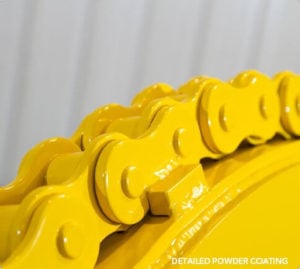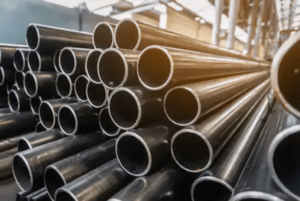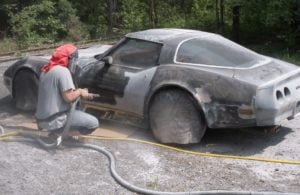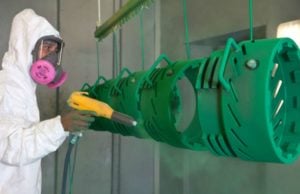Galvanizing is known as the process of applying a protective coating to steel or iron. The coating is made of zinc and is applied to protect the metal from the surrounding environment.
In this piece, we’ll define Galvanization, how it’s carried out, and explore its many benefits.
Why Galvanize?
Galvanization acts as a deterrent to atmospheric changes. It’s the most effective way to prevent metal from rusting.
When a piece of steel is galvanized, the layer that’s formed is a barrier between the galvanized steel and prevents the formation of iron oxide – stopping the rusting process.
It provides effective corrosion resistance to exposed steel parts and is a long-lasting and cost-effective method to increase the longevity of steel products such as sheet metal or pipes. All of which are prone to substantial environmental damage.
As a result, a galvanized pipe or galvanized sheet metal is immune to environmental components such as acid rain or other hindering changes.
Industrial Powder Coating Galvanization
Industrial Powder Coating Galvanization is a more modern approach to metal protection and conservation.
A base of polymer resin systems with leveling agents, flow modifiers, curatives, and other ingredients are used to create a coating polymer system.
The powder coating method represents over 15% of the dry finishing market and is used for both functional and decorative purposes. The most significant perk of galvanized powder coating is it’s available in many textures and colors.
Related: What are Industrial Coatings?
How Is Powder Coating Done?
Powder coatings are polymer resin systems which are combined with curatives, pigments, leveling agents, flow modifiers, and other additives. It’s then melted, mixed and cooled to give a product similar to baking powder.
Electrostatic Spray Deposition or ESD is used to apply the powder uniformly on a metal substance. This method uses a spray gun, which discharges electrostatic charge to the powder particles, making them stick to the grounded substance.
After this spraying process, the metal substrate is placed in a curing oven or a powder coating oven. This is done to let the coating chemically adhere. The heat from the coating results in molecular changes that provide a long-lasting layer. These molecular chains are highly resistant to breakdowns.
The finish is done in either satin, gloss, or matte style.
Why Go For Industrial Powder Coating?
Powder coating is a highly durable finishing technique. It’s commonly found in many household items and industrial items as well. It is perfect for harsh conditions such as factories, lumber houses, etc. It is the ideal balance between performance and attractiveness. The flexible range of options with respect to texture, color, and style is unmatched.
Apart from being durable, powder coating also has environmental advantages.
Related: Why Use Different Industrial Coatings?
Benefits of Galvanized Powder Coating
Safe and Environmentally Friendly
The process of using industrial powder coating is free of any harmful chemicals or solvents. This results in few or no volatile compounds and producing and applying powder coating a safe and environmentally conscious process.
Wide Range Of Options
Using powder coating for galvanizing or for galvanized sheet doesn’t limit color choices. It’s available in limitless colors and textures, thus making it commercially viable and adjustable for one’s aesthetic needs.
Durable
Powder coating is highly resilient and durable as compared to galvanized paint. Coating integrity is maintained while making room for flexibility and bending without compromising on quality and durability. It is resistant to scratching, fading, and wear than other finishes.
Regulatory Compliance
Elimination of waste and VOCs or Volatile Organic Compounds help companies comply with regulations set forth by the regulations of the U.S. Department of Environmental Protection Agency and saves a lot of overhead costs which are otherwise unavoidable.
High-Application Frequency
Another advantage from an economic perspective, powder coating has an application frequency of 99%. Not only that, but one can also reuse the overspray. This results in a further reduction of wastage and helps make the most of the powder.
Takeaway
Powder coating is usually done over galvanized steel to increase the durability and resilience to environmental changes. This ensures a lifespan of roughly 50+ years of rust-free operation to the galvanized metal. These coatings give additional economic lifespan to structures and protect against aggressive environmental changes.
It’s possible to use these two methods separately or on their own. Both powder coating and galvanizing are stand-alone techniques, providing the same results in varying degrees. It falls upon the requirements, budget, and willingness of the user to determine which method(s) work best for them.
If one’s looking for a more flexible approach, with durability, assurance of longevity, and a cost-effective method to preserve steel, galvanized powder coating is the best option.
The ability of decorative application of powder coating makes it viable for indoor use as well as outdoor, industrial use. There are various pretreatment procedures in place which enhance the effects of powder coating. If one wants options in textures, colors, and finishes, powder-coated steel is the best bet.
Powder coating provides an efficient, environmental, and accessible solution to meeting steel preserving needs. The barrier created by powder coating prevents destructive materials from reaching the surface of the metal while the decorative aspect gives it an economical edge as compared to other methods.
Galvanized Industrial Powder Coating is a 360-degree solution that is suitable for one’s home, business, or industry that is also easy on the wallet. It gives the metal an aesthetic appeal while reserving its structure, thus letting it function effectively and increasing it’s economical value and maintaining structural integrity.
Related: Why Powder Coating? 10 Pros and Cons






